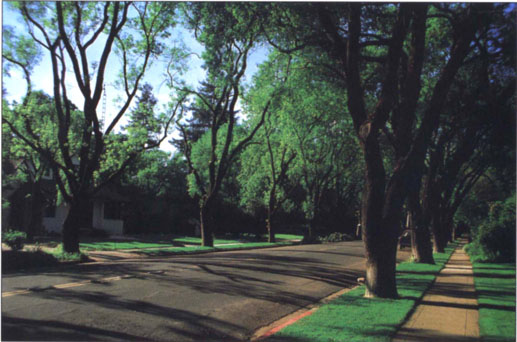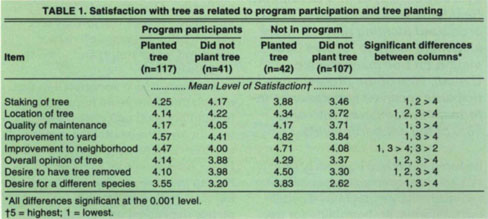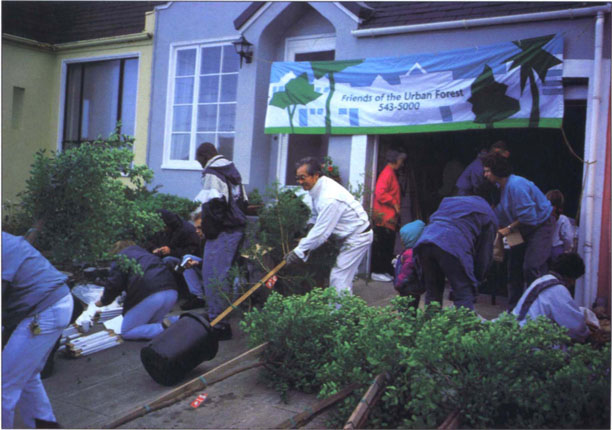All Issues
Community programs promote tree care
Publication Information
California Agriculture 51(5):23-25. https://doi.org/10.3733/ca.v051n05p23
Published September 01, 1997
PDF | Citation | Permissions
Abstract
Trees provide shade, reduce noise and make cities more attractive, among other benefits, but their survival depends on long-term care from humans. A survey of residents in three California cities found that people who planted trees themselves were more satisfied with the outcome than residents whose trees were planted by a city employee or a developer. Residents who participated in an organized planting program were also more likely to receive information on tree maintenance. Overall, 90% of the program participants received maintenance information, compared with only 16% of the nonparticipants.
Full text
Trees create shade, reduce noise and provide wildlife habitat, as well as make neighborhoods more attractive.
Reduced municipal budgets have had serious consequences for tree-planting and maintenance programs throughout California. Responsibility for trees has shifted from city governments to nonprofit organizations. There are currently 55 local tree-planting organizations affiliated with California ReLeaf, a coordinating group with headquarters in San Francisco. Urban forestry in California relies on partnerships between the private sector, government and these local organizations.
Research has shown that trees make cities more attractive (improve visual aesthetics), raise property values, provide shade (which can lower energy consumption in summer), reduce noise and water runoff and provide wildlife habitat.
Evidence is also accumulating that tree planting can be an important tool in neighborhood and civic revitalization. In turn, the health and survival of city trees require neighborhood action. Forest trees can grow independent of human intervention, but city trees during their early years are almost completely dependent on humans for their survival. It is not enough merely to select suitable varieties of trees and get them into the ground; they must be protected and cared for on a long-term basis. Urban forester Morgan Grove, who has been assisting community programs in Baltimore, remarks, “We don't know if we are organizing communities to plant trees or planting trees to organize communities.” The approximately 1,500 trees planted in Baltimore's community program have an 80% survival rate, compared to a 50% rate for plantings by city crews.
Survey of residents' satisfaction
In 1993, the U.S. Forest Service funded a multifaceted study as part of a national initiative to plant more trees in urban areas and improve their survival rate. Other researchers are looking at water and soil issues and at the effects of trees on air quality and noise suppression. Our objective was to discern which attributes of street trees are valued most by city residents and to find ways to encourage proprietary attitudes so homeowners will maintain these trees properly.
Our research focused on urban tree-planting programs in California. We compared residents who had planted trees themselves, either as part of an organized program or independently, with residents in the same communities whose trees had been planted by the city or a developer. We compared satisfaction levels with the species planted, the way the planting was done, access to tree-maintenance information (which is considered essential for long-term tree health) and the social benefits of being part of a neighborhood program.
To locate programs that emphasized community participation, we contacted state and local forestry personnel who identified several California cities where we could compare trees planted by voluntary organizations and those planted by outside agencies. We selected programs in cities where the organizations had a high level of involvement with their residents.
The first study was done in 1993 in three Fresno neighborhoods where tree planting had been coordinated by Tree Fresno, which started in 1985 as an independent, volunteer-based organization. The next two studies took place in 1994 and 1995 in Sacramento and Galt, where plantings had been coordinated by the Sacramento Tree Foundation (STF). Started in 1982 as an all-volunteer organization, the foundation expanded rapidly. In 1990 it began a major initiative sponsored by the Sacramento Municipal Utility District to plant 50,000 trees a year for 10 years.
In each location we obtained a list of addresses where trees had been planted under the sponsorship of a community program. Two researchers walked through the neighborhoods to ascertain that the planted trees still existed. These visits were also used to record the addresses of nearby houses with street trees of similar size and shape. We constructed a 20-item questionnaire to assess respondents' attitudes toward their trees and the neighborhood. The format was similar to that of other tree surveys conducted by our research team. Questions were multiple choice, with space at the end for written comments.
The survey was mailed to residents. Because the envelopes were addressed without peoples' names, we added a personal touch to the letters. The resident's address and the researcher's return address were handwritten in blue ink. The cover letter was personally signed by a researcher, who included a handwritten note at the bottom indicating the resident's tree species and location in the yard. Three weeks after the initial mailing, a follow-up letter containing another copy of the questionnaire and a return envelope was sent to all nonresponding households. Return rate exceeded 50%, and there was no indication of nonrespondent bias. On the basis of their responses, residents were classified as to whether they had been part of a community planting program, then further classified as to whether or not they had planted the trees themselves. The survey queried their satisfaction with various aspects of tree planting, including staking the tree, location in the yard, and satisfaction with the species planted. Other questions concerned satisfaction with the tree species and location, whether or not the homeowner wanted the tree removed or replaced, the degree of neighbor contact during planting and access to maintenance information.
Benefits of community programs
Among the groups, there were significant differences in satisfaction with the way the tree had been staked or supported when it was planted, the location selected for the tree, the way the tree was being maintained, the impact of the tree on the yard and the neighborhood, the desire to have the tree replaced, the wish that a different species had been planted originally and overall satisfaction with the tree (table 1). On all of these items, residents whose trees were planted by a developer or by the city were less satisfied with the outcome than were residents whose trees were planted as part of a community program or who selected and planted the tree themselves.
Because people associated with a community program were more likely to have planted trees themselves, a statistical technique (partial correlation) was used to separate the effects of program membership from planting the tree oneself. This showed that planting the tree oneself was a more important contributor to resident satisfaction with the tree than was program membership.
Membership in an organized program made an enormous difference in whether or not the respondent received information on tree maintenance. Overall, 90% of the program participants received maintenance information, compared with only 16% of the nonparticipants. This is important because an evaluation of a 1986 planting by the Sacramento Tree Foundation indicated that attendance at an initial tree-planting demonstration increases tree survival. Almost two-thirds (63%) of the program participants said they would contact the program if the tree became sick, compared with only 13% of the nonprogram people. The other information sources listed, such as nurseries, a garden guide, a friend or a neighbor, were mentioned in almost equal proportion by program participants and nonparticipants. Participation in an organized program did not diminish the use of other resources but provided an important additional option.
The most evident social benefits of community planting programs were in neighbor assistance and friendships. There was more neighbor assistance among program participants than among nonparticipants, which led participants to become better acquainted with their neighbors. Interviews conducted at planting sessions revealed instances of neighbors meeting for the first time. However, the community-building aspects of tree planting extend beyond putting trees in the ground. The decision to plant trees reflects a commitment to the future. There is a saying that a garden expresses a commitment for a season, while a tree expresses a commitment for a lifetime.
Voluntary organizations are shifting their emphasis from planting to maintenance. As an example, the Sacramento Tree Foundation has created a separate organization to inspect elm trees for signs of Dutch elm disease. Trained volunteers visit designated blocks and report back to the city, which is responsible for removing infected trees. Volunteers receive technical information on tree health and disease and also learn how to work with city agencies to maintain the health of a valuable local resource. This type of partnership is typical of the new urban forestry.
In conclusion, this study shows that involvement in planting trees, either done independently or as part of a community program, increases satisfaction with the tree. Relative to planting trees independently, membership in a community program brings additional advantages in terms of neighbor assistance and access to technical information, both of which have been found to enhance tree survival.







